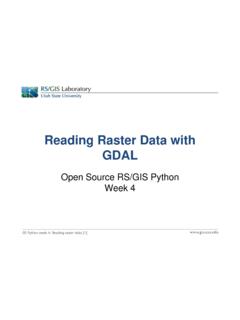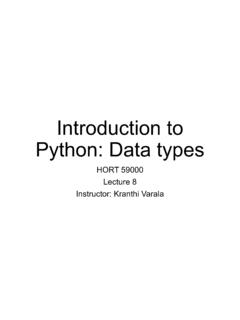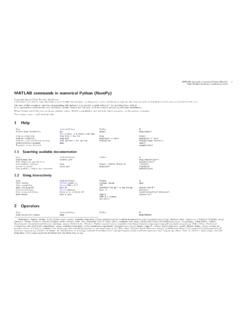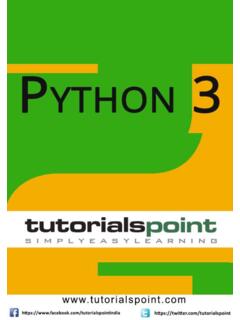Transcription of Cheat sheet Pandas Python - DataCamp
1 Python For data Science Cheat SheetPandas BasicsLearn Python for data Science Interactively at Python for data Science InteractivelySeriesDataFrame4 7-53dcbaA one-dimensional labeled array capable of holding any data type IndexIndexColumnsA two-dimensional labeled data structure with columns of potentially different typesThe Pandas library is built on NumPy and provides easy-to-use data structures and data analysis tools for the Python programming language.>>> import Pandas as pdUse the following import convention: Pandas data Structures>>> s = ([3, -5, 7, 4], index=['a', 'b', 'c', 'd'])>>> data = {'Country': ['Belgium', 'India', 'Brazil'], 'Capital': ['Brussels', 'New Delhi', 'Bras lia'], 'Population': [11190846, 1303171035, 207847528]}>>> df = ( data , columns=['Country', 'Capital', 'Population'])Selection>>> s['b'] Get one element -5>>> df[1.]
2 ] Get subset of a DataFrame Country Capital Population 1 India New Delhi 1303171035 2 Brazil Bras lia 207847528 By Position>>> [[0],[0]] Select single value by row & 'Belgium' column>>> ([0],[0]) 'Belgium' By Label>>> [[0], ['Country']] Select single value by row & 'Belgium' column labels>>> ([0], ['Country']) 'Belgium' By Label/Position>>> [2] Select single row of Country Brazil subset of rows Capital Bras lia Population 207847528>>> [:,'Capital'] Select a single column of 0 Brussels subset of columns 1 New Delhi 2 Bras lia >>> [1,'Capital'] Select rows and columns 'New Delhi' Boolean Indexing>>> s[~(s > 1)] Series s where value is not >1>>> s[(s < -1) | (s > 2)] s where value is <-1 or >2 >>> df[df['Population']>1200000000] Use filter to adjust DataFrame Setting>>> s['a'] = 6 Set index a of Series s to 6 Applying Functions>>> f = lambda x.
3 X*2>>> (f) Apply function>>> (f) Apply function element-wiseRetrieving Series/DataFrame Information>>> (rows,columns) >>> Describe index >>> Describe DataFrame columns>>> () Info on DataFrame>>> () Number of non-NA valuesGetting Also see NumPy ArraysSelecting, Boolean Indexing & SettingBasic InformationSummary>>> () Sum of values >>> () Cummulative sum of values >>> () () Minimum/maximum values>>> () () Minimum/Maximum index value >>> () Summary statistics>>> () Mean of values>>> () Median of valuesDropping>>> (['a', 'c']) Drop values from rows (axis=0)>>> ('Country', axis=1) Drop values from columns(axis=1) data Alignment>>> (s3, fill_value=0) a b c d >>> (s3, fill_value=2)>>> (s3, fill_value=4)>>> (s3, fill_value=3)>>> s3 = ([7, -2, 3], index=['a', 'c', 'd'])>>> s + s3 a b NaN c d Operations with Fill MethodsInternal data AlignmentNA values are introduced in the indices that don t overlap:You can also do the internal data alignment yourself with the help of the fill methods.
4 Sort & Rank>>> () Sort by labels along an axis>>> (by='Country') Sort by the values along an axis>>> () Assign ranks to entriesBelgiumBrusselsIndiaNew DelhiBrazilBras lia012 CountryCapital11190846130317103520784752 8 PopulationI/ORead and Write to CSV>>> (' ', header=None, nrows=5)>>> (' ')Read and Write to Excel>>> (' ')>>> (' ', sheet_name='Sheet1') Read multiple sheets from the same file>>> xlsx = (' ')>>> df = (xlsx, 'Sheet1')>>> help( )Asking For HelpRead and Write to SQL Query or Database Table>>> from sqlalchemy import create_engine>>> engine = create_engine('sqlite:///:memory:')>>> ("SELECT * FROM my_table;", engine)>>> ('my_table', engine)>>> ("SELECT * FROM my_table;", engine)>>> ('myDf', engine)read_sql()is a convenience wrapper around read_sql_table() and read_sql_query()






